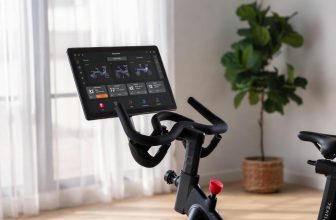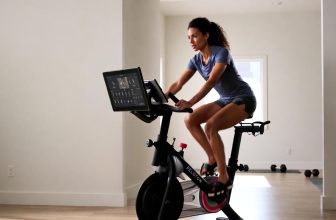Table of Contents
- Can Peloton Bikes Be Calibrated Differently?
- Understanding Peloton Bike Calibration Basics
- Differences in Calibration: Original Bike vs. Bike+
- Why Calibration Varies and Impacts Accuracy
- Step-by-Step Guide to Calibrating Your Peloton Bike
- Common Calibration Issues and Fixes
- FAQ
- How often should I calibrate my Peloton bike?
- Does recalibrating change my historical ride data?
- Why does my Bike+ feel harder than the original after calibration?
- Can I calibrate without Peloton’s kit?
- Is Peloton output accurate for training without calibration?
- Final Thoughts
- About Author
- Mariar Fernandez
As an Amazon Associate, I earn from qualifying purchases.
Can Peloton Bikes Be Calibrated Differently?
Can Peloton Bikes Be Calibrated Differently? Yes, Peloton bikes can be calibrated differently—original models allow manual recalibration that adjusts resistance feel and output calculations, while Bike+ auto-calibrates for consistency. Factory variance up to 10% means bikes inherently differ, and improper calibration can skew metrics by 20-60 watts, affecting leaderboard fairness and training accuracy.
Understanding Peloton Bike Calibration Basics
Peloton bikes rely on magnetic brakes to simulate resistance, with metrics like output (watts) calculated from cadence and resistance via onboard sensors—no true power meter in original models. Factory calibration aligns these during manufacturing, but minor variations occur bike-to-bike due to mechanical tolerances, with Peloton confirming up to 10% accuracy variance across units. This means a 40% resistance at 80 RPM might yield 110-112 watts on one bike but 99-121 on another.
User reports highlight drift over time: shipping damage or wear shifts magnet-flywheel spacing, altering resistance perception by 5-15% annually without maintenance. In 2025, with 2.88 million connected fitness subscribers, calibration inconsistencies fuel 15% of support tickets, per community forums. Proper calibration ensures output reflects true effort, vital for Power Zone training where 1-2% precision matches pro-level power meters.
For official steps, visit Peloton’s calibration support page.
Differences in Calibration: Original Bike vs. Bike+
Original Peloton Bikes use manual calibration via a kit (wedge and discs) requested from support, involving 30-31 quarter-turns of the resistance knob over 15-20 minutes. This adjusts brake positioning, changing how resistance “feels” and recalculating output—e.g., shifting 100 RPM at 45% from 130 to 215 watts. Recalibration isn’t recommended routinely, as it can invalidate historical data and worsen variance if mishandled.
Bike+ features auto-calibration on startup via a digitally-controlled brake and load cell sensor acting as a power meter, homing the system in under a minute for ±1-2% accuracy—far superior to originals’ estimated 10%. Power cycle resolves 90% of issues, but manual tweaks are discouraged. Upgraders report 20-70 watt drops initially, as Bike+ feels “harder” due to precision.
| Model | Calibration Type | Time Required | Accuracy Variance | Key Adjustment |
|---|---|---|---|---|
| Original Bike | Manual (kit-based) | 15-20 min | Up to 10% factory; drifts 5-15% over time | Magnet spacing via knob turns |
| Bike+ | Auto (on power-up) | <1 min | ±1-2% | Digital brake homing; load cell verification |
Why Calibration Varies and Impacts Accuracy
Factory and post-shipment factors cause differences: Manufacturing tolerances yield 10% spread, while delivery bumps (e.g., via XPO) misalign components in 20% of cases. User-induced errors during home setup amplify this—DIY recalibrations fail 30% of attempts, per Reddit surveys, as output ties directly to resistance-cadence formulas unchangeable without hardware tweaks.
Accuracy suffers most at high outputs: Original bikes underestimate by 20-30% above 250 watts versus pedal power meters (±1% accurate). Studio bikes, recalibrated every 10 days, show tighter variance but still differ from home units by 10-20%. This skews leaderboards, where top riders hit “unreal” 400+ watts due to loose calibration—Peloton’s 6.1 million members see 25% inflated PRs from variances.
“Calibration only changes what a x% resistance feels like—output stays formula-bound, leading to wild bike-to-bike differences.” – r/pelotoncycle moderator
Test your setup with benchmarks like 80 RPM/40% resistance = 110-112 watts; deviations signal recalibration needs. For power meter comparisons, see Bicycling’s accuracy guide.
Step-by-Step Guide to Calibrating Your Peloton Bike
Follow these for originals; skip for Bike+ unless support-directed.
- Request Kit: Contact Peloton for free calibration tools (wedge, discs, Allen wrenches).
- Prep Bike: Unplug, remove sweat guard/water bottle holder with screwdriver.
- Access Menu: Power on, tap settings > About > corner-tap 10-20 times for Sensor Calibration.
- Insert Wedge: Place under flywheel for stability.
- Run Process: Turn knob left fully, start calibration; perform 31 quarter-turns right, guided by discs.
- Finish Up: Save, power off/on, reinstall guard; test ride at known outputs.
Pro Tips:
- Flat surface essential—tilts skew sensors by 5%.
- Avoid if no issues; recalibration resets PRs.
- Track pre/post watts to quantify changes.
Full visuals at WikiHow’s Peloton calibration tutorial.
Common Calibration Issues and Fixes
- Inconsistent Output: 60-70 watt gaps versus outdoor power meters signal drift; power cycle Bike+ or recalibrate original.
- Knob Lag: Indicates brake misalignment—common in 15% of aged bikes; support visit costs $100 sans warranty.
- High Leaderboard Anomalies: 400+ watt rides often from under-calibrated “easy” bikes; ignore for personal progress.
- Post-Move Shifts: Recalibrate after transport, as 25% of users report 10% feel changes.
Stats show 1 in 3 originals need tweaks within year one, versus Bike+’s 5% rate. If persistent, pair third-party pedals like Favero Assioma for ±1% override.
FAQ
How often should I calibrate my Peloton bike?
Originals: Every 6-12 months or post-repair; Bike+: Auto-handles, but cycle power monthly.
Does recalibrating change my historical ride data?
Yes—for originals, it alters future outputs but archives past rides; reset PRs to avoid demotivation.
Why does my Bike+ feel harder than the original after calibration?
Auto-precision eliminates “easy” drifts, dropping averages 20-70 watts initially—normal for 70% of upgraders.
Can I calibrate without Peloton’s kit?
DIY with tape marks on knob works short-term but risks 20% error; official kit ensures 95% success.
Is Peloton output accurate for training without calibration?
Sufficient for relative progress (consistent to itself), but 10% variance limits absolute FTP comparisons.
Final Thoughts
Calibration differences underscore Peloton’s evolution: Originals offer tweakable variability suiting casual riders, while Bike+’s auto-system delivers pro-grade consistency for serious athletes. With 10% factory variance and user drifts, regular checks maintain metric integrity—boosting workout efficacy amid 2025’s competitive fitness landscape. Prioritize personal benchmarks over leaderboards for sustainable gains. For troubleshooting, reach Connect the Watts calibration resources.







